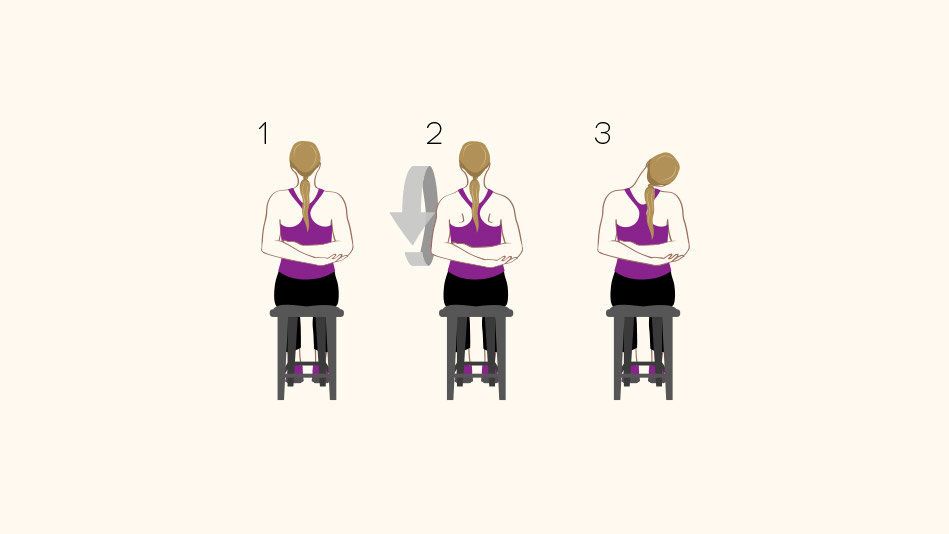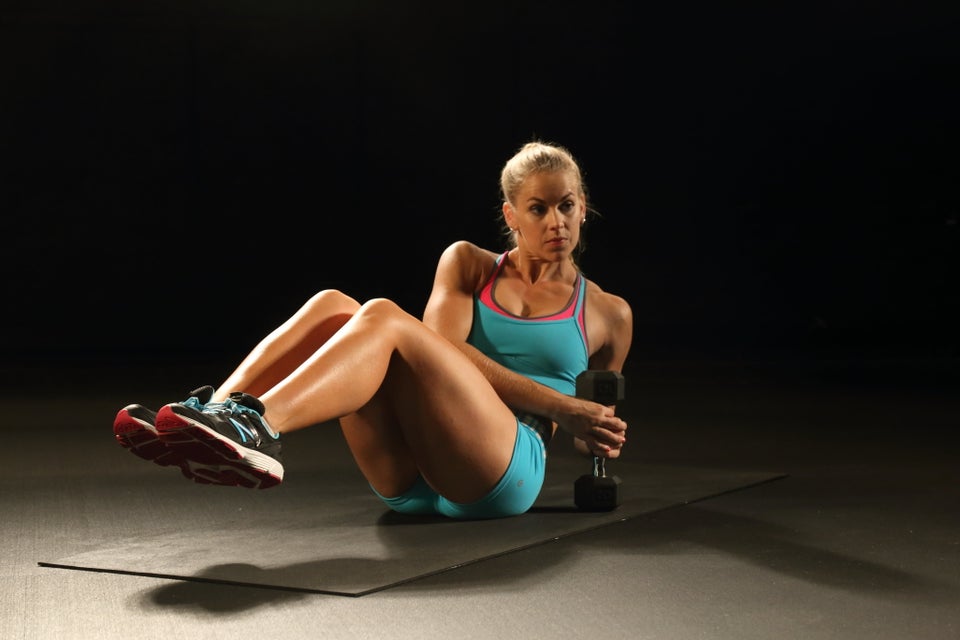1
Opposite-Elbow Grab

Illustration: David Wyffels
Hold each stretch for up to 60 seconds if you're trying to improve your flexibility. If you're just looking to relieve tightness, 15 to 30 seconds will do the trick.
Do it if: You hunch over a computer or smartphone all day, or tend to carry stress in your neck and shoulders. This is also a great move for swimmers, who are prone to tightness in the chest and shoulders.
1. Sitting up tall in a comfortable position, bend both elbows and reaching your hands behind your back, try to grab the opposite elbow.
2. Holding opposite wrists or forearms (depending on how far you can comfortably reach), roll your shoulders down and back to feel the stretch in your chest and the front of your shoulders.
3. Drop your right ear toward your right shoulder, then switch sides, to stretch your neck and the muscles that connect it to your clavicle.
Do it if: You hunch over a computer or smartphone all day, or tend to carry stress in your neck and shoulders. This is also a great move for swimmers, who are prone to tightness in the chest and shoulders.
1. Sitting up tall in a comfortable position, bend both elbows and reaching your hands behind your back, try to grab the opposite elbow.
2. Holding opposite wrists or forearms (depending on how far you can comfortably reach), roll your shoulders down and back to feel the stretch in your chest and the front of your shoulders.
3. Drop your right ear toward your right shoulder, then switch sides, to stretch your neck and the muscles that connect it to your clavicle.
2
Trunk Rotation

Illustration: David Wyffels
Do it if: You're really stiff in your torso, lower back and hips. If you're into trendy rowing classes, this can relieve tightness in the trunk that comes from the repetitive motion.
1. Sit in a chair or on a bench and place your hands behind your head with your elbows out, like you'd do during a crunch.
2. Rotate your trunk to the right, going as far as you comfortably can.
3. Once you've reached your farthest point, move your torso up and down like you're bowing, to really feel the stretch in your ribcage. If you're tight in your lower back and hips, you'll feel it there too. Return to center and repeat on your left side.
1. Sit in a chair or on a bench and place your hands behind your head with your elbows out, like you'd do during a crunch.
2. Rotate your trunk to the right, going as far as you comfortably can.
3. Once you've reached your farthest point, move your torso up and down like you're bowing, to really feel the stretch in your ribcage. If you're tight in your lower back and hips, you'll feel it there too. Return to center and repeat on your left side.
3
Seated Figure Four

Illustration: David Wyffels
Do it if: You're tight in your glutes and hips. Cyclists and Spin-class devotees might consider adding this to their regimen.
1. While seated, cross one ankle over the opposite knee while keeping the top foot flexed. If you're already feeling it in your glutes and hips, stop and hold.
2. If you want to go a little deeper, place one hand on your top knee and gently press down as you lean forward slightly. This will open up the hip joint, and you may even feel the stretch in your low back. Switch legs and repeat on opposite side.
1. While seated, cross one ankle over the opposite knee while keeping the top foot flexed. If you're already feeling it in your glutes and hips, stop and hold.
2. If you want to go a little deeper, place one hand on your top knee and gently press down as you lean forward slightly. This will open up the hip joint, and you may even feel the stretch in your low back. Switch legs and repeat on opposite side.
Advertisement
4
Thomas Stretch

Illustration: David Wyffels
Do it if: You spend most of the day sitting, which shortens your hip flexors and leads to tightness. And treadmill-class fans should take note too, as tight hip flexors can lead to improper running form and cause potential injury.
1. Sit on the edge of a bed or countertop and lie back as you bring one knee to the chest.
2. Let your other leg dangle over the edge, but don't let your lower leg touch the ground. If it does, you need a higher surface to lie on. You should feel it in the hip of the lower leg and a little bit in the glute of the leg you've brought to your chest. Return to start, switch legs and repeat the stretch.
1. Sit on the edge of a bed or countertop and lie back as you bring one knee to the chest.
2. Let your other leg dangle over the edge, but don't let your lower leg touch the ground. If it does, you need a higher surface to lie on. You should feel it in the hip of the lower leg and a little bit in the glute of the leg you've brought to your chest. Return to start, switch legs and repeat the stretch.
5
Wall Hamstring Stretch

Illustration: David Wyffels
Do it if: The backs of your legs feel tight, from the hamstring to the calf, or if you've got heel pain (tight calves can contribute to the problem). Any form of exercise that involves your legs can cause tightness here—from sprint intervals to walking a few miles a day.
1. Find a spot along a wall or in a wide doorway where you can lie down and put one leg comfortably up the wall while the other leg extends straight out in front of you. An L-shaped corner, where you're on the outside of the L, will work best.
2. Sit down, then lie back and extend one leg up the wall. Bend your other leg and rest that thigh against the wall.
3. Scoot your hips as close to the wall as you can to feel the stretch in the hamstring and a bit in the lower leg. Switch legs and repeat.
Source: Jacque Crockford, certified strength and conditioning specialist and exercise physiologist with the American Council on Exercise.
1. Find a spot along a wall or in a wide doorway where you can lie down and put one leg comfortably up the wall while the other leg extends straight out in front of you. An L-shaped corner, where you're on the outside of the L, will work best.
2. Sit down, then lie back and extend one leg up the wall. Bend your other leg and rest that thigh against the wall.
3. Scoot your hips as close to the wall as you can to feel the stretch in the hamstring and a bit in the lower leg. Switch legs and repeat.
Source: Jacque Crockford, certified strength and conditioning specialist and exercise physiologist with the American Council on Exercise.
Also on HuffPost:
